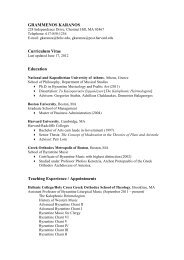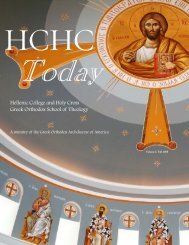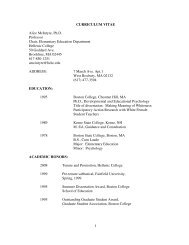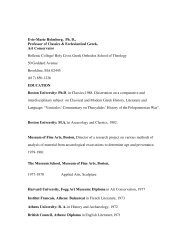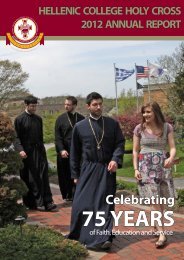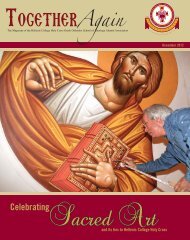GREEK, ROMAN AND BYZANTINE OBJECTS ... - Hellenic College
GREEK, ROMAN AND BYZANTINE OBJECTS ... - Hellenic College
GREEK, ROMAN AND BYZANTINE OBJECTS ... - Hellenic College
Create successful ePaper yourself
Turn your PDF publications into a flip-book with our unique Google optimized e-Paper software.
12<br />
3.II Roman Coins<br />
Coins were introduced by the Roman Republic relatively late, around 300 BC,<br />
compared to their Greek neighbors in the East. The Greek colonies in Italy (such<br />
as Naples, Taranto, Heraclea, Croton, Thurii) had already been using coins for<br />
most of the previous three centuries. Scholars have argued that the adoption of<br />
coinage by the Romans was based on cultural considerations and arose out of a<br />
need to adopt a Greek institution during a time when the Roman world was<br />
becoming increasingly influenced by <strong>Hellenic</strong> culture. The earliest type of Roman<br />
coinage were large bronze bars, weighing more than 1,500 grams and known as<br />
aes signatum ('struck bronze'). Alongside these, the Romans issued silver and<br />
bronze coins similar in style and design to those of the southern Italian Greek<br />
colonies.<br />
The main denominations until the middle of the third century were the<br />
aureus (gold), the denarius (silver), the sestertius and dupondius (both brass) and<br />
the as (copper). In the third century, the denarius was replaced by the antoninianus<br />
or radiate (double denarius) which was replaced towards the end of the third<br />
century by the argenteus (silver) and the follis (silvered bronze), introduced<br />
during the monetary reforms of Diocletian. After Diocletian's reforms and until<br />
the end of the Empire in the West, Roman coins were mainly the gold solidus<br />
(continued in the early and middle Byzantine period) and small bronze<br />
denominations.<br />
The early Republican circular coins were decorated with personifications<br />
of the city of Rome and various gods and goddesses driving a biga or quadriga<br />
(two-horse and four-horse chariot respectively). The role of deciding which<br />
images were used on coins belonged to a committee of three young statesmen<br />
with aspirations to the senatorial rank known as the tresviri monetales ('trio of<br />
money-men', an institution that began in 298 BC and lasted until the middle of<br />
the third century. Julius Caesar increased the number of the committee from<br />
three to four. Initially, there was no mention of the names of the money-men on<br />
the coins. Later the small symbols, letters or monograms were replaced with<br />
abbreviated forms of the money-men's names. Some of the appointees to this<br />
institution eventually began using the coins to display images related to their<br />
family history. This self-promoting imagery was part of the ever-increasing<br />
competition amongst the Roman ruling elite. A significant change in design was<br />
made when Julius Caesar became the first Roman to issue coins bearing his own<br />
portrait rather than those of family ancestors or symbols.



